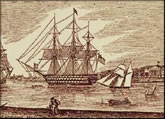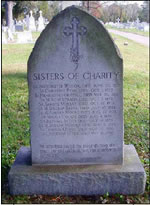
|

Summer 2005 CourierNorfolk’s Yellow Fever Epidemic of 1855By Peggy Haile McPhillipsJuly 2005 marks the 150th anniversary of the yellow fever epidemic
of
On June 7, 1855, the steamer Ben Franklin arrived in Hampton Roads from the Virgin Islands, where yellow fever was rampant. Two crewmen had died of the fever along the way. The steamer lay in quarantine for twelve days before going to a Gosport shipyard for repairs, under orders that her bilges not be pumped out, orders that the Captain disobeyed. Another crew member came down with the fever on June 21 and died the next day. A fourth man died on July 8th. After the disease spread along Irish Row, a tenement on the Portsmouth waterfront, those residents evacuated to Barry’s Row in Norfolk. Yellow fever was epidemic there by early August. The homes and all their contents on Barry’s Row were burned to the ground on the night of August 9, a futile attempt to curb the spread of yellow fever.
Citizens fled both cities in panic. At Old Point, they were turned away by soldiers with bayonets. Other cities enforced quarantine or imposed fines. But some doors remained open, notably those in Richmond, Mathews County and Fredericksburg, and on the Eastern Shore. Governor-elect Henry Wise took refugees into his own home and set up tents on the lawn for the overflow. By August, businesses and offices had closed. Church services were suspended. Doctors and nurses came from around the country to offer their services, many falling prey to the disease. When the Sisters of Charity came down from Maryland aboard the Old Bay Line, Anne Herron invited them into her large home on Church Street to tend yellow fever victims. It was Norfolk’s first public hospital and the forerunner of today’s Bon Secours DePaul. Miss Herron, who died of the fever in September 1855, left her home and estate to the Sisters of Charity to carry on their work in Norfolk. At peak around the first of September, as many as 80 people died per day – with 400 burials in the first week of the month. In all, there were an estimated 1,000 deaths in Portsmouth and 2,000 in Norfolk, about a third of those who did not flee.
The Richmond Daily Dispatch attempted to frame the significance of the numbers in an article published on October 4, 1855: “Some idea of the destructiveness of the pestilence in Norfolk may be formed from comparing it with the great Plague in London. In that plague, one in seventeen died; in Norfolk, one in three. In fact, we know of no pestilence which has ever visited any part of the world, equal in destruction to that which has desolated the City of Norfolk.” The fever abated after the first frost in October, and the editor of Norfolk’s Southern Argus newspaper wrote “In the short space of ninety days, out of an average population of 6,000, every man, woman and child, almost without exception, has been stricken … and about 2,000 have been buried. But the storm is over, and again our good ship lays her course...her flag…sadly at half mast.”
|
You Are Here: Home > Essays and Artifacts > Insights from The Courier > Summer 2005 > Norfolk’s Yellow Fever Epidemic of 1855 www.NorfolkHistorical.org |




